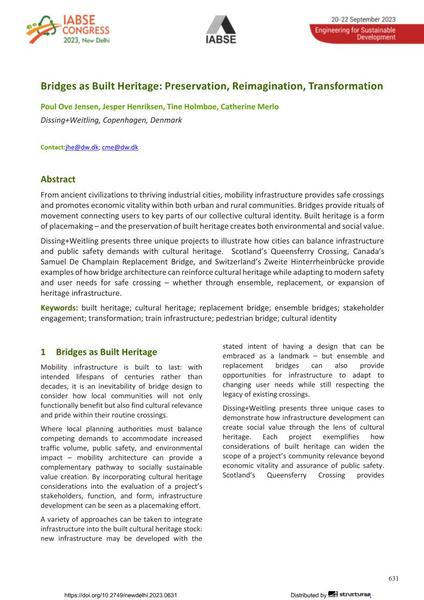Bridges as Built Heritage: Preservation, Reimagination, Transformation

|
|
|||||||||||
Bibliografische Angaben
| Autor(en): |
Poul Ove Jensen
(Dissing+Weitling, Copenhagen, Denmark)
Jesper Henriksen (Dissing+Weitling, Copenhagen, Denmark) Tine Holmboe (Dissing+Weitling, Copenhagen, Denmark) Catherine Merlo (Dissing+Weitling, Copenhagen, Denmark) |
||||
|---|---|---|---|---|---|
| Medium: | Tagungsbeitrag | ||||
| Sprache(n): | Englisch | ||||
| Tagung: | IABSE Congress: Engineering for Sustainable Development, New Delhi, India, 20-22 September 2023 | ||||
| Veröffentlicht in: | IABSE Congress New Delhi 2023 | ||||
|
|||||
| Seite(n): | 631-639 | ||||
| Anzahl der Seiten (im PDF): | 9 | ||||
| DOI: | 10.2749/newdelhi.2023.0631 | ||||
| Abstrakt: |
From ancient civilizations to thriving industrial cities, mobility infrastructure provides safe crossings and promotes economic vitality within both urban and rural communities. Bridges provide rituals of movement connecting users to key parts of our collective cultural identity. Built heritage is a form of placemaking – and the preservation of built heritage creates both environmental and social value. Dissing+Weitling presents three unique projects to illustrate how cities can balance infrastructure and public safety demands with cultural heritage. Scotland’s Queensferry Crossing, Canada’s Samuel De Champlain Replacement Bridge, and Switzerland’s Zweite Hinterrheinbrücke provide examples of how bridge architecture can reinforce cultural heritage while adapting to modern safety and user needs for safe crossing – whether through ensemble, replacement, or expansion of heritage infrastructure. |
||||
| Stichwörter: |
Fußgängerbrücke Kulturerbe
|
||||
